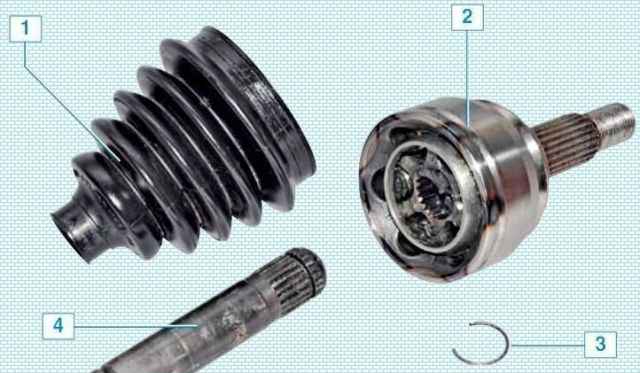The front wheel drives consist of external and internal constant velocity joints (CV joints) connected by drive shafts
The external hinge allows only angular movements of the connected shafts.

The internal joint, in addition to the angular ones, provides axial displacement of the shafts when the front wheels are turned and the suspension is working.
The wheel speed sensor drive ring is pressed onto the outer joint housing.
Berfield-type external joint consists of a body, cage, cage and six balls.
Grooves for accommodating balls are made in the hinge body and in the cage.
In the longitudinal plane, the grooves are made along the radius, which provides the required angle of rotation of the outer hinge.
The splined tip of the outer joint housing is installed in the front wheel hub and attached to it with a nut.
The cage of the outer joint is mounted on the splines of the shaft and fixed on the shaft with a retaining ring.

The internal drive of the front wheel of the "Tripod" type consists of a body and three rollers on needle bearings, put on the trunnions of a three-studded hub.
Slots for rollers are made in the hinge body.
The three-stud hub is fixed on the shaft with a retaining ring.
The rollers allow the hub to move in the slots of the pivot housing in the axial direction, so that the drive can be extended or shortened to compensate for the mutual movements of the suspension and the power unit.
The tip of the body of the internal hinge with internal splines is fixed on the intermediate shaft of the box with a spring retaining ring installed in the groove of the shaft.

The balls of one sorting group are installed in the outer hinge.
All parts of the hinge are selectively matched to each other, so it is impossible to repair the hinge by replacing individual parts.
Only the hinge assembly is supplied as a spare part, as well as a small repair kit consisting of a retaining ring, boot, boot clamps and, in some cases, grease.
The inner hinge is supplied as spare parts in the form of two repair kits: a large one, which includes all the hinge parts, and a small one, similar to the outer hinge repair kit.
For the lubrication of the hinges, a special lubricant with molybdenum disulfide (domestic analogue - SHRUS-4) was used.
The cavities of all hinges are protected from road dirt and water by rubber corrugated covers fixed to the hinge bodies and drive shafts, respectively, with large and small clamps.
The drive shafts differ in length, so the drives of the right and left wheels are not interchangeable.
To reduce vibration in the transmission, a dynamic damper is installed on the shaft of the right drive, fixed with a clamp similar to the small clamps of the covers
The drive joints are very durable, their design life is almost equal to that of a car.
In operation, they are changed or repaired quite often due to damage to the protective covers. Such work is expensive and time-consuming.
To save a lot of money, regularly check the condition of the protective covers of the hinges and replace them immediately if they are damaged.
If water or dust gets into the hinge through a damaged cover, it will fail after several hundred kilometers.
The sealed hinge wears extremely slowly
Possible malfunctions of front wheel drives and methods of correction
Cause of malfunction Remedy
Vibration when driving:
Heavy wear wheel drive narrow joint - Replace worn joint
Deformation of the wheel drive shaft - Replace the joint assembly
Worn wheel drive inner joint rollers - Replace inner joint
Loose hub nut - Tighten or replace nut
Moving the car to the side:
Worn or damaged inner joint race - Replace joint
Worn or damaged outer hinge - Same
Damage or deformation of the wheel drive shaft - Replace the shaft
Loose hub nut - Tighten or replace nut
Grease leaking out of hinge:
Worn or torn outer or inner hinge protective boot - Replace damaged boot and grease
Insufficient tightening of the clamps - Replace and securely tighten the clamps
Noise, knock from the front wheel when the car is moving:
Damage or deformation of the wheel drive shaft - Inspect the joint, replace if there is play.
Front wheel drive shaft runout - Replace shaft
Worn wheel drive inner joint rollers - Replace inner joint
Loose hub nut - Tighten or replace nut
Knock when car turns:
Severe wear on outer wheel drive joint - Replace joint





